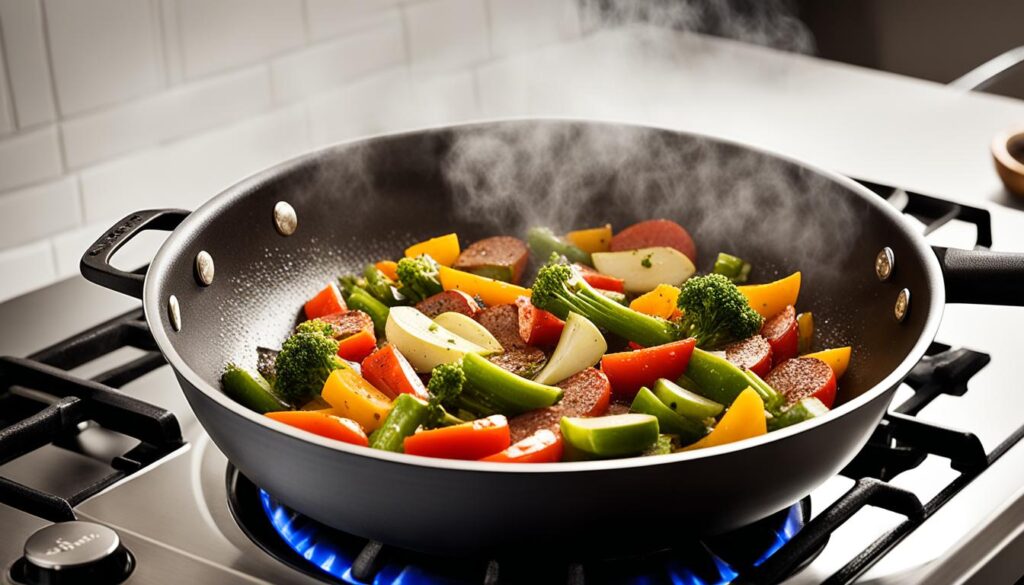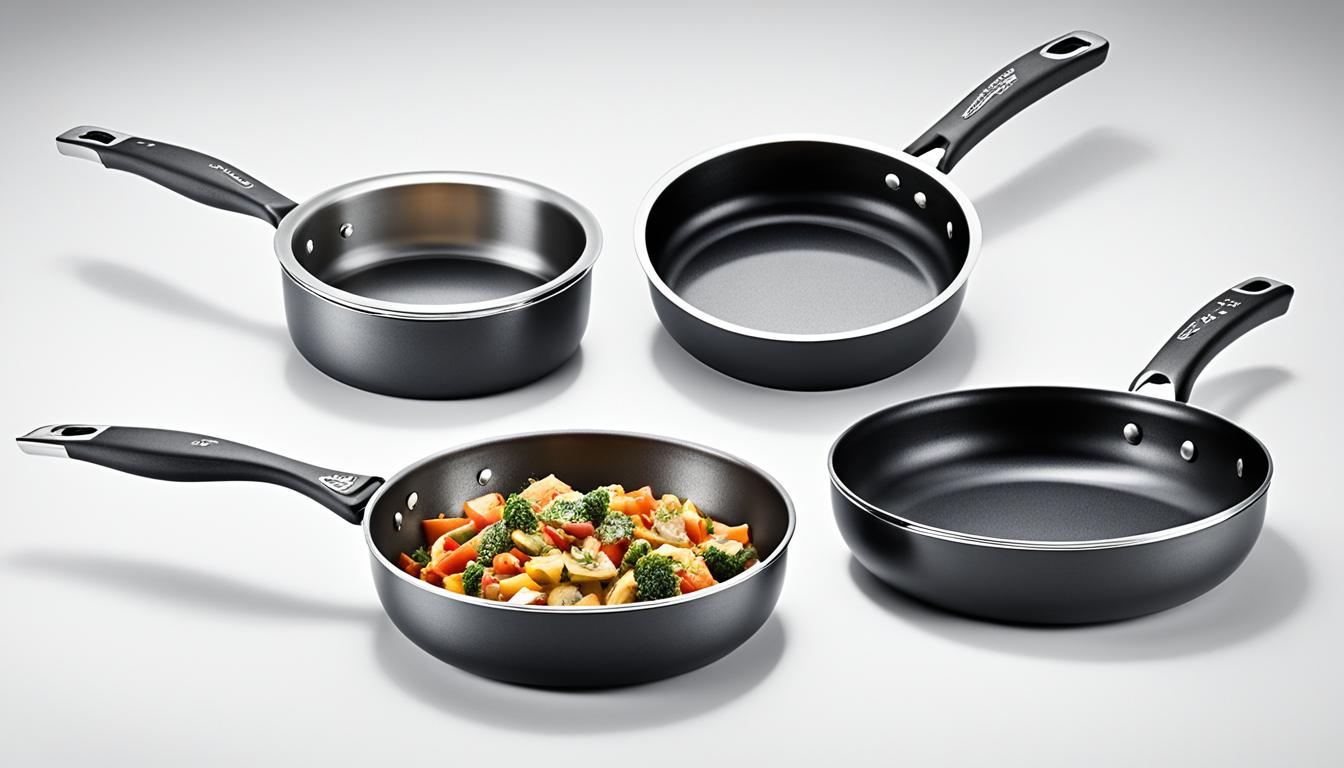Have you ever wondered what sets a skillet, fry pan, and saute pan apart? Are they just different names for the same kitchen tool, or do they each have unique characteristics and uses? Let’s dive into the world of cookware and explore the differences between these popular culinary essentials.
When it comes to the stovetop, having the right tools can make all the difference in your cooking experience. Skillets, fry pans, and saute pans are all versatile cookware pieces that can help you whip up delicious meals. But understanding their nuances can help you choose the perfect pan for your culinary needs.
Key Takeaways:
- Skillets, fry pans, and saute pans are often used interchangeably, but they have unique characteristics.
- A skillet, also known as a frying pan or fry pan, is a shallow pan with slanted sides, ideal for stir-frying and sautéing.
- A saute pan has straight sidewalls, making it suitable for tasks that involve cooking ingredients in liquid, such as shallow frying or braising.
- The shape of the pan affects surface area and volume, with skillets having a smaller cooking area compared to saute pans.
- Skillets are lighter and excel at tossing ingredients, while saute pans are heavier and offer better heat retention.
What is a Skillet?
A skillet, also known as a frying pan or fry pan, is a shallow pan with slanted sides. It is commonly used for stir-frying and sautéing, cooking methods that involve quick cooking in a small amount of oil or fat over high heat. The slanted sides of the skillet make it easier to stir, flip, and toss ingredients for even cooking.
Skillets are versatile cookware that can be used for various culinary tasks. In addition to stir-frying and sautéing, they are great for searing meat, making pasta dishes, or preparing delicious pan sauces.
One of the popular choices for skillets is stainless steel cookware. Stainless steel skillets are known for their durability, even heat distribution, and versatility in the kitchen. Having a stainless steel skillet as part of your cookware collection can elevate your cooking experience and allow you to explore a wide range of recipes with ease.
So whether you’re whipping up a quick stir-fry or sautéing vegetables for a flavorful side dish, a skillet is a must-have tool for any cooking enthusiast.
Benefits of Using a Skillet:
- Quick and efficient cooking with even heat distribution.
- Versatile for a wide range of cooking methods, from stir-frying to searing.
- Easy to stir, flip, and toss ingredients.
- Compatible with various stovetop types.
- Durable and long-lasting.
Understanding the Saute Pan
A saute pan is a versatile cooking tool with straight sidewalls, setting it apart from skillets and frying pans. Unlike skillets with slanted sides, the saute pan’s straight walls make it ideal for tasks requiring cooking ingredients in liquid such as shallow frying or braising. But don’t be fooled by its name – a saute pan can also be used for sautéing, stir-frying, and searing.
While sautéing can be done in both skillets and saute pans, some chefs prefer the slanted sides of skillets. The slanted sides allow for easy shaking and flipping of ingredients, ensuring even cooking. However, if you’re looking to take on shallow frying or braising, saute pans are the go-to choice due to their straight sidewalls that contain the liquids and prevent splattering.
If you’re in the mood for a quick stir fry or need to sear some meat, the saute pan can handle these tasks with ease. Its wide surface area and flat bottom provide ample space to toss and flip ingredients, facilitating even cooking.
“The saute pan’s straight sidewalls are designed for cooking ingredients in liquid, making it perfect for shallow frying and braising, while still allowing for sautéing and searing.”
When it comes to choosing between a saute pan and a skillet, consider the specific cooking methods you intend to use. If you frequently engage in shallow frying or braising tasks, a saute pan is a great investment. However, if you prefer the versatility of a skillet for sautéing, stir-frying, and searing, the slanted sides make it a more popular choice for those cooking styles.

Comparing Surface Area and Volume
The shape of the pan plays a significant role in determining its surface area and volume. When comparing skillets and saute pans, one noticeable difference is the cooking area each offers.
Skillets, with their slanted sides, have a smaller cooking area compared to saute pans. For example, a 12-inch skillet will have 30% less cooking area than a 12-inch saute pan. This variation in surface area directly influences the cooking capacity of each pan.
Skillets are well-suited for smaller portions, making them ideal for individual meals or recipes that require less cooking space. On the other hand, saute pans provide a larger cooking area, allowing for higher volumes of ingredients and liquids. This makes them a better choice when cooking for larger groups or preparing recipes that require more space.
Ultimately, the decision between a skillet and a saute pan depends on the specific cooking needs and the quantities of food being prepared.

Comparative Surface Area and Volume of Skillet and Saute Pan
| Pan Type | Cooking Area | Volume Capacity |
|---|---|---|
| Skillet | Smaller due to slanted sides | Less than saute pan |
| Saute Pan | Larger due to straight sides | More than skillet |
Weight and Tossing Ability
Saute pans and skillets differ in their weight and tossing ability, affecting their performance in the kitchen. Saute pans, with their wider base and straight sidewalls, tend to be heavier than skillets. This added weight may require the use of a helper handle to comfortably lift and move the saute pan during cooking.
On the other hand, skillets are lighter, making them easier to shake and stir ingredients for even cooking. The tossing ability of a skillet allows for efficient distribution of heat and ensures that vegetables or meat pieces cook evenly. This is particularly beneficial when preparing stir-fries or sautés, where quick and even cooking is essential to achieving delicious results.
So, whether you prefer a saute pan or a skillet depends on your cooking style and preferences. If you enjoy tossing ingredients to ensure even cooking, a skillet may be the ideal choice. However, if you prioritize the capacity and straight sidewalls of a saute pan, you may opt for the added weight and stability it provides.
Evaporation and Reducing Abilities
The shape of the pan can have a significant impact on the rate of evaporation and the ability to reduce sauces. Skillets, with their slanted sides, facilitate rapid evaporation, making them highly efficient for searing meats and achieving a beautiful caramelization. The slanted design allows excess moisture to evaporate quickly, resulting in a crispy and flavorful crust on the meat. The wide cooking area of the skillet also promotes efficient browning.
Both skillets and sauté pans can be used effectively to reduce sauces; however, there are a few differences to consider. Given the same cooking area, sauté pans have similar reducing abilities to skillets. The straight sidewalls of a sauté pan help retain liquids and prevent excessive evaporation when reducing sauces.
While skillets excel in rapid evaporation, reducing sauces in larger quantities may require multiple batches due to their smaller cooking area. On the other hand, sauté pans offer a larger cooking area, making them more suitable for reducing greater volumes of sauces in a single batch. The straight sidewalls of a sauté pan also make it easier to stir and scrape the bottom of the pan when reducing sauces, helping to prevent burning or sticking.
In summary, both skillets and sauté pans have their unique advantages when it comes to evaporation and reducing abilities. Skillets are excellent for achieving quick evaporation and intense browning, while sauté pans have similar reducing capabilities and can handle larger quantities of sauces in a single batch.
Choosing the Right Pan for Your Needs
When it comes to selecting the right cookware for your kitchen, it’s essential to consider your specific cooking needs. Skillets and saute pans are both versatile options, each with its own set of advantages.
Skillet Advantages
Skillets are great for sautéing and other versatile cooking tasks. Their slanted sides make it easy to toss and stir ingredients, ensuring even cooking and flavor distribution. Skillets are perfect for searing meats, making stir-fries, and preparing pan sauces. Their compact size also makes skillets convenient for small kitchens or limited stovetop space.
Saute Pan Advantages
Saute pans, on the other hand, excel in shallow frying, moderate-temperature searing, and braising. With their straight sidewalls, saute pans have a larger cooking area compared to skillets. This makes them perfect for cooking larger volumes of ingredients and sauces. Saute pans are ideal for achieving crispy textures and for recipes that require more liquid and mixing.
Stainless Steel Pans with Triple-Layer Construction
When it comes to pan construction, stainless steel pans with triple-layer construction are recommended for their durability, even heat distribution, and temperature control. The triple-layer construction consists of an aluminum or copper core sandwiched between two layers of stainless steel. This design ensures optimal heat conductivity and avoids hot spots, allowing for precise cooking results every time.
Choosing the Right Pan
When deciding between a skillet and a saute pan, consider your cooking preferences and the types of recipes you often prepare. If you’re just starting and want a versatile pan that can handle a variety of dishes, a skillet is an excellent choice. However, if you frequently cook dishes that require shallow frying, searing, or braising, a saute pan may be a better fit for your needs.
In terms of pan construction, always opt for stainless steel pans with triple-layer construction for superior heat distribution and control. Avoid pans with disk bottoms, as they tend to have uneven heat distribution. Additionally, look for riveted handles for enhanced durability and stability.
Remember, the right pan can make a significant difference in your cooking experience and the quality of your dishes. Consider your specific needs and choose a pan that will help you achieve the best results in the kitchen.
| Skillet | Saute Pan |
|---|---|
| Versatile for sautéing and a variety of cooking tasks | Excellent for shallow frying, searing, and braising |
| Compact size for small kitchens or limited stovetop space | Larger cooking area for higher volumes of ingredients |
| Easy to toss and stir ingredients for even cooking | Perfect for achieving crispy textures and mixing in more liquid |
| Ideal for searing meats, making stir-fries, and preparing pan sauces | Great for recipes that require more liquid and cooking in batches |
Conclusion
After exploring the differences between skillets, fry pans, and saute pans, it is clear that each type of pan has its own unique advantages and suitability for various cooking methods. Understanding these differences can greatly assist you in selecting the most appropriate cookware for your kitchen.
While the terms skillet, fry pan, and saute pan are often used interchangeably, it is important to consider the shape and design of each pan when making your decision. Skillets, with their slanted sides, are ideal for stir-frying, sautéing, and general versatile cooking tasks. On the other hand, saute pans with straight sidewalls are better suited for shallow frying, moderate-temperature searing, and braising.
When choosing your cookware, remember to take into account your own cooking preferences and needs. Stainless steel pans with triple-layer construction are recommended for even heat distribution and superior temperature control. Additionally, opt for pans with riveted handles for maximum durability. By selecting the appropriate skillet or saute pan, you can enhance your culinary skills and enjoy the process of cooking even more.
